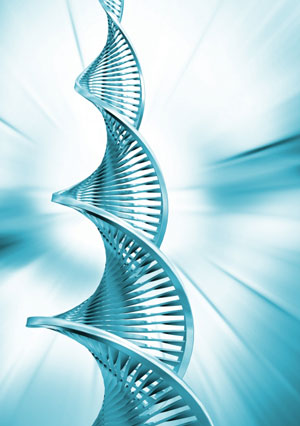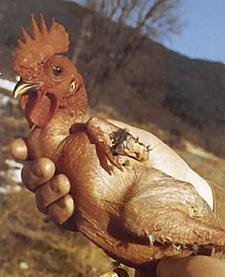Genetics: no friend of evolution
A highly qualified biologist tells it like it is.
Genetics and evolution have been enemies from the beginning of both concepts. Gregor Mendel, the father of genetics, and Charles Darwin, the father of modern evolution, were contemporaries. At the same time that Darwin was claiming that creatures could change into other creatures, Mendel was showing that even individual characteristics remain constant. While Darwin’s ideas were based on erroneous and untested ideas about inheritance, Mendel’s conclusions were based on careful experimentation. Only by ignoring the total implications of modern genetics has it been possible to maintain the fiction of evolution.

To help us develop a new biology based on creation rather than evolution, let us sample some of the evidence from genetics, arranged under the four sources of variation: environment, recombination, mutation, and creation.
Environment
This refers to all of the external factors which influence a creature during its lifetime. For example, one person may have darker skin than another simply because she is exposed to more sunshine. Or another may have larger muscles because he exercises more. Such environmentally-caused variations generally have no importance to the history of life, because they cease to exist when their owners die; they are not passed on. In the middle 1800s, some scientists believed that variations caused by the environment could be inherited. Charles Darwin accepted this fallacy, and it no doubt made it easier for him to believe that one creature could change into another. He thus explained the origin of the giraffe’s long neck in part through ‘the inherited effects of the increased use of parts’.1 In seasons of limited food supply, Darwin reasoned, giraffes would stretch their necks for the high leaves, supposedly resulting in longer necks being passed on to their offspring.
Recombination
This involves shuffling the genes and is the reason that children resemble their parents very closely but are not exactly like either one. The discovery of the principles of recombination was Gregor Mendel’s great contribution to the science of genetics. Mendel showed that while traits might be hidden for a generation they were not usually lost, and when new traits appeared it was because their genetic factors had been there all along. Recombination makes it possible for there to be limited variation within the created kinds. But it is limited because virtually all of the variations are produced by a reshuffling of the genes that are already there.
For example, from 1800, plant breeders sought to increase the sugar content of the sugar beet. And they were very successful. Over some 75 years of selective breeding it was possible to increase the sugar content from 6% to 17%. But there the improvement stopped, and further selection did not increase the sugar content. Why? Because all of the genes for sugar production had been gathered into a single variety and no further increase was possible.
Among the creatures Darwin observed on the Galápagos islands were a group of land birds, the finches. In this single group, we can see wide variation in appearance and in life-style. Darwin provided what I believe to be an essentially correct interpretation of how the finches came to be the way they are. A few individuals were probably blown to the islands from the South American mainland, and today’s finches are descendants of those pioneers. However, while Darwin saw the finches as an example of evolution, we can now recognize them merely as the result of recombination within a single created kind. The pioneer finches brought with them enough genetic variability to be sorted out into the varieties we see today.2
Mutation

Now to consider the third source of variation, mutation. Mutations are mistakes in the genetic copying process. Each living cell has intricate molecular machinery designed for accurately copying DNA, the genetic molecule. But as in other copying processes mistakes do occur, although not very often. Once in every 10,000–100,000 copies, a gene will contain a mistake. The cell has machinery for correcting these mistakes, but some mutations still slip through. What kinds of changes are produced by mutations? Some have no effect at all, or produce so small a change that they have no appreciable effect on the creature. But many mutations have a significant effect on their owners.
Based on the creation model, what kind of effect would we expect from random mutations, from genetic mistakes? We would expect virtually all of those which make a difference to be harmful, to make the creatures that possess them less successful than before. And this prediction is borne out most convincingly. Some examples help to illustrate this.
Geneticists began breeding the fruit fly, Drosophila melanogaster, soon after the turn of the century, and since 1910 when the first mutation was reported, some 3,000 mutations have been identified.3 All of the mutations are harmful or harmless; none of them produce a more successful fruit fly—exactly as predicted by the creation model.
Is there, then, no such thing as a beneficial mutation? Yes, there is. A beneficial mutation is simply one that makes it possible for its possessors to contribute more offspring to future generations than do those creatures that lack the mutation.
Darwin called attention to wingless beetles on the island of Madeira. For a beetle living on a windy island, wings can be a definite disadvantage, because creatures in flight are more likely to be blown into the sea. Mutations producing the loss of flight could be helpful. The sightless cave fish would be similar. Eyes are quite vulnerable to injury, and a creature that lives in pitch dark would benefit from mutations that would replace the eye with scar-like tissue, reducing that vulnerability. In the world of light, having no eyes would be a terrible handicap, but is no disadvantage in a dark cave. While these mutations produce a drastic and beneficial change, it is important to notice that they always involve loss of information and never gain. One never observes the reverse occurring, namely wings or eyes being produced on creatures which never had the information to produce them.

Natural selection is the obvious fact that some varieties of creatures are going to be more successful than others, and so they will contribute more offspring to future generations. A favourite example of natural section is the peppered moth of England, Biston betularia. As far as anyone knows, this moth has always existed in two basic varieties, speckled and solid black. In pre-industrial England, many of the tree trunks were light in colour. This provided a camouflage for the speckled variety, and the birds tended to prey more heavily on the black variety. Moth collections showed many more speckled than black ones. When the Industrial Age came to England, pollution darkened the tree trunks, so the black variety was hidden, and the speckled variety was conspicuous. Soon there were many more black moths than speckled [Ed. note: see Goodbye, peppered moths for more information].
As populations encounter changing environments, such as that described above or as the result of migration into a new area, natural selection favours the combinations of traits which will make the creature more successful in its new environment. This might be considered as the positive role of natural selection. The negative role of natural selection is seen in eliminating or minimizing harmful mutations when they occur.
Creation
The first three sources of variation are woefully inadequate to account for the diversity of life we see on earth today. An essential feature of the creation model is the placement of considerable genetic variety in each created kind at the beginning. Only thus can we explain the possible origin of horses, donkeys, and zebras from the same kind; of lions, tigers, and leopards from the same kind; of some 118 varieties of the domestic dog, as well as jackals, wolves and coyotes from the same kind. As each kind obeyed the Creator’s command to be fruitful and multiply, the chance processes of recombination and the more purposeful process of natural selection caused each kind to subdivide into the vast array we now see.
References
- Darwin, C., The Origin of Species, 6th Edition, John Murray, London 1902, p. 278. Darwin did see natural selection acting on this and other causes of variation as an important factor in giraffe neck evolution, but not many are aware of his reliance on inheritance of acquired characteristics. Return to text.
- The different species of Galápagos finches have been observed interbreeding at times, clear evidence that they belong to the same created kind. Return to text.
- Lindsley, D.L., and Grell, E.H., Genetic Variations of Drosophila melanogaster, Carnegie Institution of Washington, Publication No. 627, 1967. Return to text.



Readers’ comments
Comments are automatically closed 14 days after publication.